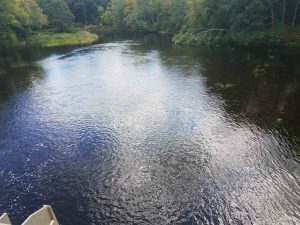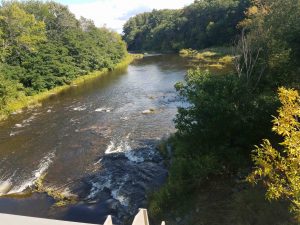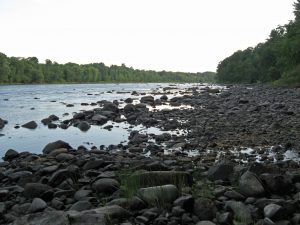SMART School: Bangor High School
Location: Bangor, Maine
Mentors: Cary James (cjames@bangorschools.net), Chris Packard (cpackard@bangorschools.net)
SMART student researchers: Madeline Ahola, Maher Alsamsam, Rowan Andrews, Maddie Brookings, Meaghan Caron, Hannah Dunn, Amara Ifeji, Lily McLaughlin, Melissa Tian, Marina Mohawass (Point Person, m.mohawass16@gmail.com)
Group meeting time: Tuesdays at 2:15 pm EST
Watershed: Penobscot River Watershed, mainly Kenduskeag Stream
Research sites:
Kenduskeag; 6 Mile Falls Bridge 44° 49′ 31″ N 68° 48′ 23″ W. This Location contains two sampling sites, above (Site 1) and below (Site 2) the 6 Mile Falls Bridge.
 |
 |
Kenduskeag; Brown Brook outfall 44° 44′ 49″ N 68° 58′ 26″ W 14 km. Three sampling sites below Griffin Road Bridge: Site 3 is above Brown Brook outfall where it joins with the Kenduskeag Stream. Site 4 is at the Brown Brook outfall and Site 5 is below Brown Brook outfall.
 |
Kenduskeag; Valley Avenue 44° 43′ 29″ N 68° 47″ W 10 km. Site 6 is below the I-95 Bridge, above the Arctic Brook outfall. Site 7 is at the outfall where Arctic Brook joins the Kenduskeag Stream. Site 8 is below Arctic Brook outfall.
Team goals and research topics:
- The Effects of Stormwater on Four Maine Oligotrophic Lakes and Their Susceptibility to Eutrophication from Hypolimnetic Phosphorus Release and Non-Native Plant Invasion
- Analysis of Biological Contamination on Littoral Zones of Seven Recreational Freshwater Beaches in Maine
- Removal of Heavy Metals (Co, Cu, Fe, Mn, Pb, Zn) from Synthetic Stormwater Using Bacterial Cellulose Encompassed Activated Carbon Fruit Peels
- Continuing to Monitor the Water Quality of the Kenduskeag Stream
- Creating a digital catalog for the identification of macroinvertebrates and invasive plants species.
- Oxygen isotope ratio Analysis
- Using Celluslose nanofibers and calcium carbonate to filter surfactants from stormwater



